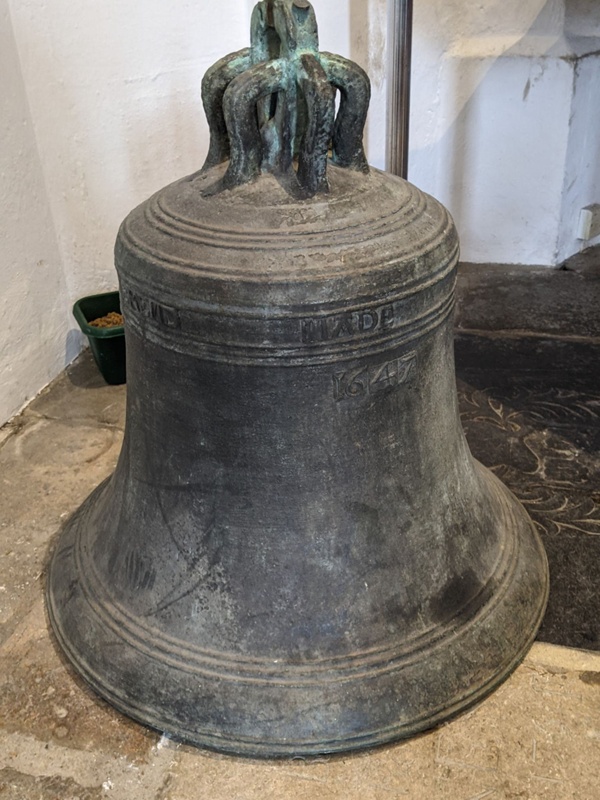After doing her placement as a Collections Assistant at NHCT in 2022, Lucy Rule tells us about her favourite object, the Bell of All Saints Church. Lucy documented the objects of St Martin at Palace Church and made them available on online catalogue, via the eHive platform.
To search our online catalogue, visit https://ehive.com/collections/203298/norwich-historic-churches-trust.
__
The bell on display at St Martin at Palace served in the tower of All Saints from 1647 to 2001. Embossed with the phrase ‘JOHN BRENT MADE ME IN 1647’ (the Brents were a well-known family of bellmakers), it comes from an exciting period of Norwich history.
The All Saints bell was forged in tumultuous times for both Norwich and England. The English Civil War had raged for five years. King Charles had been captured but escaped to form an alliance with Scottish forces. Norwich, a parliamentary city, had provided troops across the southeast of the country. However, the Mayor of Norwich, John Utting, a royalist, was forcibly removed from the post for his beliefs in 1648. This led to riots across the city and one such disturbance on April 24th near the armoury at Bethel Street caused dozens of barrels of gunpowder to catch fire. The subsequent explosion, later known as ‘The Great Blow’, is believed to have killed around 100 people and shattered the windows of St Stephens and St Peter Mancroft, causing thousands of pounds’ worth of damage. The churches survived however, and St Stephens soon rang its bell in celebration.
The tradition of using bells for religious purposes dates to the eighth century when missionaries used small handbells to attract and gather people together. Over time, larger bells were introduced into churches, first in the Middle East and eventually in Europe. The Reformation saw the destruction of many of the early church bells but also saw the invention of the bell wheel, which meant bells could be rung in sequence. Churches began to hire ringers, often well paid for their work, and who were not members of the clergy. This made bell ringing a secular activity.
The seventeenth century saw bell ringing become fashionable and in 1668 Fabian Stedman published the first treatise on the subject, Tintinnalogia, outlining the principles of bell ringing and how to create compositions. Norwich even had its own composition, the curiously titled ‘Norwich Double Court Bob Major’, of which there are numerous variations. At this time the All Saints’ bell would have been the height of fashion, and it served its community for over 300 years, marking times of crisis and celebration.
Eventually, bell ringing fell out of fashion as their ringer’s reputation was tarnished by drinking. Victorian reformation saw bells cleaned and gave the clergy more control over the behaviour of their bell ringers. By 1900, bell ringers could be punished for bad behaviour. Since then, bell ringing has fallen and risen in popularity.
The bell’s rich history makes it my favourite object in the NHCT’s collection.
Lucy Rule, Collections Assistant Placement 2022 – MA Cultural Heritage and Museum Studies
Edited by Tim Cook and Sandra Martins.
If you want to know more about anything mentioned here, check out these great resources.
http://allsaintswokinghambells.org.uk/AbHistory/
https://turnersco.com/church-bells-history/
https://en.wikipedia.org/wiki/Timeline_of_the_English_Civil_War
https://norfolktalesmyths.com/2019/02/24/norwich-and-the-english-civil-war/

All Saints’ Church Bells carry on ringing… The St Giles Bell Ringers practice there once a month. To get involved, visit https://www.achurchnearyou.com/church/907/page/34137/view/.
If you’re interested in volunteering as a Collections Assistant, or writing your own blog post about our collection please email us with your idea. It can be your research on one of our objects or about your personal connection with our churches.
Image: The All Saints Church Bell in the visitor centre at St Martin at Palace Church.

Recent Comments